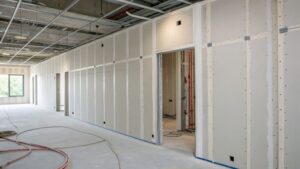Gypsum board may seem cheap per sheet, but hidden project factors can multiply the final cost in ways most buyers never expect.
A standard 4x8 gypsum board sheet usually costs between $10 and $20 depending on thickness, type, and supplier, but actual installed costs depend on labor, wastage, and project complexity.

Even if the shop quote looks simple, the number on the bill after project completion can be very different. This is because every site has different conditions, waste rates, and labor complexity.
What does gypsum cost?
Many people think gypsum costs are easy to track, but in reality they hide multiple moving parts that can shift the budget quickly.
Gypsum material price depends on sheet size, type, and market rates, but total project cost also includes waste percentage, transportation, and on-site handling1.

When I work on material sourcing, I first check raw prices from suppliers. A common ½-inch thick 4x8 sheet may be $12 at a wholesale rate. However, getting the sheet from warehouse to site, storing it safely, cutting it to fit, and handling breakage all add cost. For a flat wall, material waste may be as low as 5–8%. But a complex ceiling2 or curved wall can see waste reach 15–20% or more.
Here’s how it looks in a basic breakdown:
| Cost Component | Wall Project (approx.) | Complex Ceiling Project (approx.) |
|---|---|---|
| Raw Board Price | $12/sheet | $12/sheet |
| Waste Allowance | 5–8% | 15–20% |
| Transport per Sheet | $0.50 | $0.50 |
| Handling & Storage | $0.20 | $0.25 |
| Effective Material Cost | $12.91 | $14.75 |
From this, it becomes clear that asking “What does gypsum cost?” means asking about much more than the base price.
How do you calculate gypsum ceiling cost?
Ceiling gypsum work can quickly exceed its raw materials budget because the job demands precision and time.
To get an accurate gypsum ceiling cost, add sheet price, waste percentage3, labor hours at the required skill level, and any additional design or equipment needs.

When I calculated a ceiling job for a high-end office, the precision tolerance4 was under 2mm. We spent 40% of the total labor time just on measuring and adjusting. Material cost was only 30% of the final bill. That job also meant using extra tools and scaffolding to meet quality targets.
Here’s a simple way to approach ceiling cost calculation:
| Step | Typical Ceiling Project |
|---|---|
| Base Material Cost | $12/sheet |
| Waste Factor (15–20%) | $2.10–$2.40 |
| Skilled Labor (per m²) | $10–$15 |
| Equipment & Safety Gear | $1–$2/m² |
| Total Estimated Installed | $25–$30/m² |
If your ceiling design is complex, expect higher waste and higher skill charges. That is why sometimes the final cost is double the sheet price estimate.
What is the standard size of gypsum board?
People often assume all boards are the same size, but variations matter for cost and planning.
The most common standard size for gypsum board is 4 feet by 8 feet, though other lengths like 9, 10, or 12 feet are also available.

A standard 4x8 board is easy to move and install in many small spaces. But in commercial or tall wall projects, longer boards5 reduce joint lines and speed up work. I have supplied 4x12 boards for mall projects so workers could run fewer seams, but this increased transport difficulties and breakage risk6.
Below is a common size and specification chart:
| Board Size (ft) | Thickness Options | Common Use Cases | Handling Difficulty |
|---|---|---|---|
| 4x8 | ¼", ½", ⅝" | Homes, small rooms, repairs | Low |
| 4x10 | ½", ⅝" | Taller walls, medium-scale projects | Medium |
| 4x12 | ½", ⅝" | Large walls, commercial projects | High |
| Specialty Sizes | Varies | Special shapes, curves, design needs | Very High |
Choosing the right size is part of cost control because it affects both speed and waste.
Conclusion
The price of a gypsum board sheet is only the start. Waste, labor skill, and project complexity decide the real cost.
1、Learning about on-site handling helps you plan for labor and equipment needs during installation. ↩
2、Exploring this will show you how design complexity impacts waste, labor, and overall project cost. ↩
3、Understanding waste percentage helps you budget accurately and avoid unexpected material expenses. ↩
U4、nderstanding precision tolerance helps you see why skilled labor and time are crucial for quality results. ↩
5、Understanding when to use longer boards can help reduce seams and speed up installation. ↩
6、Learning how to minimize breakage risk saves money and prevents material loss during delivery. ↩



